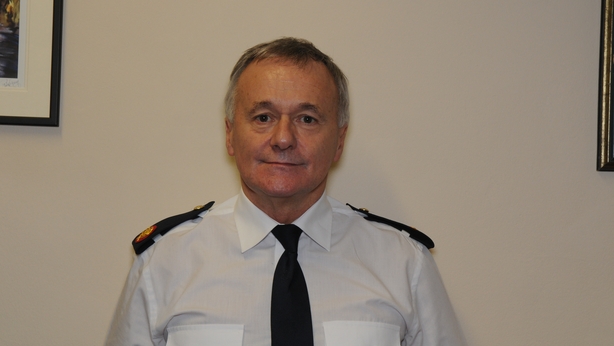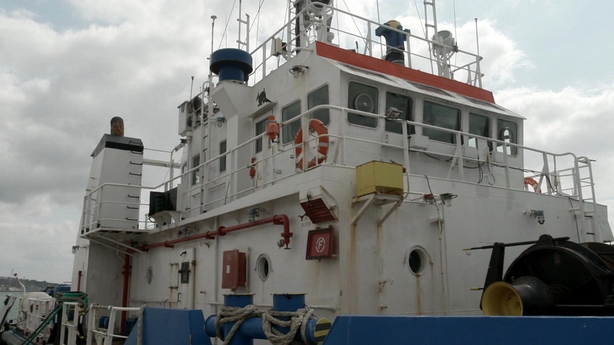This week the seizure of the MV Matthew shows the scale of drug trafficking operations being undertaken by drug cartels. In recent years, Barry Cummins has researched the operations of major drugs gangs like the Kinahan Organised Crime Gang.
He writes here about gaining access to a seized vessel which had been used to transport millions of euros worth of cocaine across the Atlantic, and the law enforcement efforts to find such boats.
It's the exercise bike that sticks in my mind. It was welded to the deck of a vessel that had been impounded in an operation by Portugal’s navy and airforce in 2019.
Unlike what we saw this week, all the action had taken place several hundred kilometres west of the Cape Verde Islands, far off the West Africa coast.
However, the process used to get there was the same: Spanish authorities had obtained information that a major cocaine consignment was en route, destined for Europe. They had shared their suspicions with their Portuguese neighbours who police a section of water far out into the Atlantic as far as the Azores. Navy personnel boarded the vessel at sea and found over two and a half tonnes of cocaine, all wrapped and ready for distribution across Europe.
Two years later I was in Lisbon, standing aboard the vessel and imagining the cocaine piled high in the storage room in which it had been found.
Michael O’Sullivan, former Assistant Garda Commissioner, and at that time the head of MAOC – the Maritime Analysis and Operations Centre, headquartered in Lisbon – was there with me.

MAOC is a collective of seven countries – Ireland, Spain, Portugal, the Netherlands, Italy, United Kingdom and France – where national police forces and each country’s navy feed into a central system and provide intelligence on suspicious boats and planes traversing the Atlantic Ocean.
The seven countries have two common issues: they are all coastal countries, and they all have significant issues with cocaine trade and use.
This week, MOAC was central to the operation which stopped the MV Matthew, resulting in the seizure of cocaine with a pure value of €157m, and a value multiple of that if cut, mixed and sold.
Looking around back then, it was hard to imagine there was once €180 million worth of contraband this boat.
A small crane was welded to the floor towards the stern, seemingly to be used to offload the cocaine to smaller craft.
"Many of the vessels that are used and that are intercepted never come to Europe," explained Mr O’Sullivan. "They pass Europe and a vessel comes out to take the drugs from them."
As I looked down towards the crane, I spotted the exercise bike. It struck me that, as this vessel had been at sea for weeks, travelling from South America towards the West African coast, those aboard would have had little opportunity to exercise.
I imagined the crew taking turns to pedal and look out at the endless sea before them. Perhaps the exercise bike gave an opportunity to monitor the horizon, and keep watch for any approaching vessels.
That hadn’t worked.
The crew had no idea that they had been watched for days from the air by the Portuguese airforce. And, when the navy approached at 5am one Wednesday morning, it was a quick boarding, and none of the cocaine was tossed overboard.
Michael walked me around some of the rooms on the ship.
"When we got here you could barely get into the room with the drugs. They were packed about that high," he said, holding his hand to shoulder level.
The drugs had been packaged back in South America and sorted for distribution to the various gangs which had clubbed together to invest in the consignment. There were markings on different packages, indicating which gang was to get whatever number of bales of cocaine.
The marking were a code known only to those in 'the criminal know’. The letters ‘F,dex’ or ‘F,olex’ written on one batch, something else on another.
The boat had crossed a vast section of water between South America and Western Europe which has been dubbed the ‘cocaine highway.’ It represented one small asset lost during a relentless effort by criminal cartels to ship cocaine to Europe.
The market for cocaine in western Europe now exceeds that of North America. Law enforcement estimate it is worth €13-14 billion annually.
South American cartels and European gangs, including the Kinahan Organized Crime Group, ship cocaine to every corner of Europe. The scale of drug seizures on the high seas is almost unimaginable to land-based law enforcement.

This week's seizure in Irish waters by the Joint Task Force of Revenue, Gardaí and Defence Forces of more than 2.2 tonnes of cocaine is the largest ever in Irish waters and indicates a very real and present situation.
Michael O’Sullivan has since left MAOC. I met him again in Dublin on Thursday, to get his take on the seizure of the MV Matthew.
"Back in the day, you would have yachts coming in," he said. "Now they're trying to get it across on industrial levels, on big ships, three, four and five tonnes at a time."
A lot of the focus of this week’s work is naturally on the Army Ranger Wing – the 'Fast Ropers’ who dramatically descended by helicopter on the MV Matthew in very challenging conditions at sea. Yet it’s been our Naval Service which has long been involved in providing key intelligence to MAOC which has led to previous seizures throughout the Atlantic.
One massive seizure of cannabis resin – €250 million worth – was made off the Canary Islands in 2021 following intelligence provided by the Irish Naval Service. It had first flagged suspicious maritime activity by a specific vessel. On foot of that, Spanish authorities began a lengthy surveillance operation and eventually swooped.
Soon after, the Spanish made another seizure, this time of €400 million worth of cannabis – again following intelligence shared by Irish counterparts.
It’s proof – as is this week’s operation - that law enforcement in Europe, along with the US Drug Enforcement Agency and other forces, have established strong links. We also know they also have developed relationships with police forces in South America to tackle the drug cartels head on.
But drug cartels have also established strong inter-group links.
"It’s a common enterprise," Mr O’Sullivan says, speaking about how major cocaine shipments are put together. "It is a number of cartels, pooling the money, buying it in bulk: get it on one ship and try and get it across... and that just quadruples the profits."
While most cocaine seizures in Europe take place off the Portuguese and Spanish coasts – and in the ports of Rotterdam and Antwerp - this week’s seizure aboard the MV Matthew shows no part of Europe is immune from being targeted, and criminal cartels will seek to exploit what they think is the area of least resistance.
In response, the likes of MAOC are determined to stop the shipments before they reach land.
"It's at its most vulnerable when it's out at sea, it's all in one ship and it's got X amount of days to get across. Once it hits the ground, it's gone in 10 different directions. If you brought in a tonne, you could be two or three years trying to seize that from house searches and stopping cars and stuff. So, the operational objective is to get it before it lands."
But that’s not easy.
As part of the same 2021 Prime Time documentary which brought me to board the cocaine-carrying vessel in Lisbon, I also spent time with Commander Tony Geraghty at Naval HQ at Haulbowline in Cork.
Standing at a large map of Ireland and the Atlantic Ocean he told me of the challenges faced at sea.
He gestured to a massive section of water from north of Donegal halfway to the Scottish Hebrides, way off west where the next stop is Iceland, then down far off the coast of Kerry deep into the Atlantic, and further south and around under Cork and towards Wexford.
"We’ve about a million square kilometres of water. The real map of Ireland is not what we are taught in school. The real map of Ireland is effectively what we see here, and the Irish Naval Service has responsibility for all the waters you see."
This week, Commander Geraghty stood with counterparts from An Garda Síochána and the Revenue Commissioners, outlining how the cocaine on the MV Matthew was seized.
The MV Matthew is many times the size of the boat I walked around near Lisbon. Both made a journey across the Atlantic with a load of cocaine, and many others will, too.
With the United Nations now saying cocaine production is happening at a scale twice that of ten years ago, and with criminal cartels using all types of seacraft to get their illegal product to the European market, the MV Matthew won’t be last boat seized.
The cocaine taken from it may not be the largest seizure in the history of the State for long.







